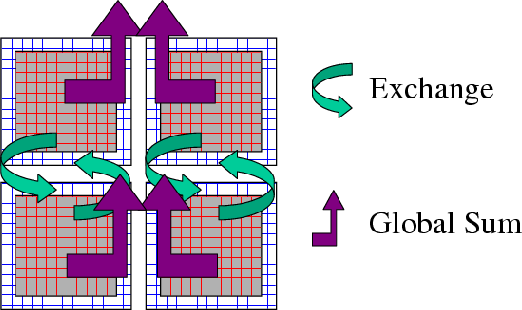 |
 |
|||||||||||
 |
|
|||||||||||
 |
 |
|||||||||||
|
Next: 4.2.9 Memory architecture Up: 4.2 WRAPPER Previous: 4.2.7 Distributed memory communication Contents
|

|
Optimized communication support is assumed to be potentially available for a small number of communication operations. It is also assumed that communication performance optimizations can be achieved by optimizing a small number of communication primitives. Three optimizable primitives are provided by the WRAPPER
- EXCHANGE This operation is used to transfer data between
interior and overlap regions of neighboring tiles. A number of
different forms of this operation are supported. These different
forms handle
- Data type differences. Sixty-four bit and thirty-two bit fields may be handled separately.
- Bindings to different communication methods. Exchange primitives select between using shared memory or distributed memory communication.
- Transformation operations required when transporting data between different grid regions. Transferring data between faces of a cube-sphere grid, for example, involves a rotation of vector components.
- Forward and reverse mode computations. Derivative calculations require tangent linear and adjoint forms of the exchange primitives.
- GLOBAL SUM The global sum operation is a central arithmetic
operation for the pressure inversion phase of the MITgcm algorithm.
For certain configurations scaling can be highly sensitive to the
performance of the global sum primitive. This operation is a
collective operation involving all tiles of the simulated domain.
Different forms of the global sum primitive exist for handling
- Data type differences. Sixty-four bit and thirty-two bit fields may be handled separately.
- Bindings to different communication methods. Exchange primitives select between using shared memory or distributed memory communication.
- Forward and reverse mode computations. Derivative calculations require tangent linear and adjoint forms of the exchange primitives.
- BARRIER The WRAPPER provides a global synchronization function called barrier. This is used to synchronize computations over all tiles. The BARRIER and GLOBAL SUM primitives have much in common and in some cases use the same underlying code.
Next: 4.2.9 Memory architecture Up: 4.2 WRAPPER Previous: 4.2.7 Distributed memory communication Contents mitgcm-support@mitgcm.org






